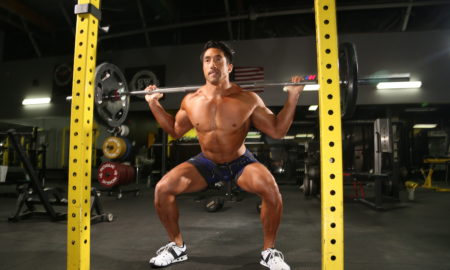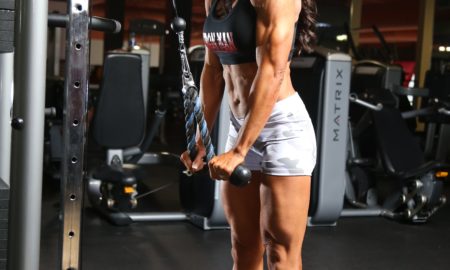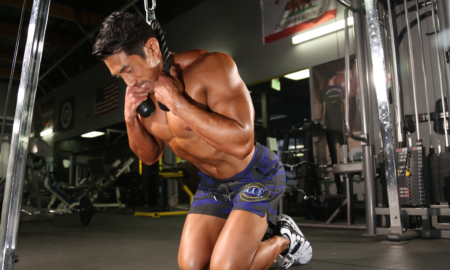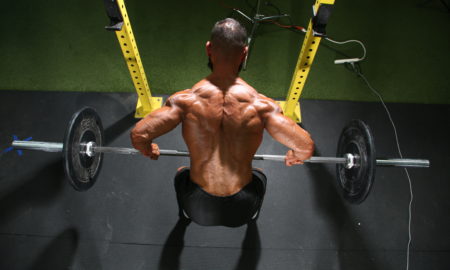 The date was August 19, 1989, and as I stood onstage at my second-ever bodybuilding competition, I listened with nervous anticipation as the announcer counted down the top five placements. I was only 20 years old, weighing in at a skinny but sharp and proportionate 171, wondering if after just three years of hard training I could actually go home as the winner of the Natural Mr. Eastern USA title.
The date was August 19, 1989, and as I stood onstage at my second-ever bodybuilding competition, I listened with nervous anticipation as the announcer counted down the top five placements. I was only 20 years old, weighing in at a skinny but sharp and proportionate 171, wondering if after just three years of hard training I could actually go home as the winner of the Natural Mr. Eastern USA title.
“In fifth place…! In fourth!” Wow, I’m still standing. They haven’t called my name yet. Is it possible? Am I dreaming? “In third place…!” Holy crap, I’m in the top two! The other guy looks pretty damn good. He’s thicker than I am and just as hard, but I know I have a better overall look. It’s apples and oranges. Fingers, toes and eyes crossed. “In second place…! And the winner of the men’s middleweight division is Eric Broser!”
The crowd goes absolutely wild—packed as it is with dozens of my friends and family members. My heart is beating wildly, and I struggle to fight back the tears. As I grab the trophy and hold it over my head, I realize that this will be one of the most memorable and satisfying moments of my life.
So here I am, 20 years later, and yes, that first win was still the sweetest. I often find myself reflecting on that day. It never fails to bring a smile to my face and a boost to my spirit. As I sit at my computer just a few months away from my 40th birthday, however, I look in the mirror and see the reflection of a physique that isn’t merely as good as it was on that winning day 20 years ago; it’s far superior. That’s right, I look bigger and better today at age 40 than I did at age 20, albeit with a few extra aches and pains. That’s the beautiful thing about the bodybuilding lifestyle: If you live it every day, you can get better with age, like a fine wine.
Even so, there are significant differences in how I must approach my training and diet at my present age compared to when I was a kid. Wait, did I just say that? Hold on a second. I still am a kid—and I have the PlayStation and Wii to prove it.
To achieve longevity in bodybuilding, especially if your goal is to continue to improve your physique over time, you must be not only consistent, dedicated and disciplined but also intelligent and calculating in your efforts. Your program must evolve if you want to keep pace with the changes in your body that naturally manifest themselves as you get older. You can’t expect to be able to train and eat as you did 20 years ago and achieve the same type of progress. In most cases that approach causes regression and, more than likely, injury. So let me discuss how my physique-building strategy differs today from 20 years ago.
Warmups
That was then: My warmups were not what you would call extensive when I was a young buck. Basically, all I’d do was walk into the gym, decide what exercise was going to be first in the routine and then do two to three progressively heavier sets of about 15, 12 and eight reps before launching into my first work set. Perhaps I’d do another quick warmup set of each new exercise after the first one, just to show my joints and nervous system the new movement and angle that were about to be attacked. That was pretty much it, and it worked fine. But that was then….
This is now: These days the first thing I do is make my way over to a treadmill or stationary cycle for a five-to-10-minute medium-paced walk or ride. I do that to get some blood pumping through my system and raise my core temperature. Luckily, I live in a warm climate; getting my body into a light sweat does not take very long.
Next I do some calisthenic-type exercises for my lower back, including side bends and twists. I’ve had some serious disk injuries in the past, so that’s vital to my warmup. From there I move to various shoulder roll and rotation movements, as well as direct rotator cuff exercises using dumbbells and/or cables. Once I’ve chosen where I’m going to start my workout, I usually do three to four progressively heavier warmup sets of that particular exercise and at least one to two warmups for each exercise thereafter. I never skip or rush through any portion of my warmup; I believe that’s essential to staving off muscular and joint injury.
Exercise Form
That was then: Compared to the average younger trainee, I usually had pretty good exercise form. Still, I often found myself getting somewhat sloppy in an attempt to move more weight than I was truly ready to handle. There was a little of the infamous bouncing of the bar off the chest to claim a bigger bench press, some serious back arch on barbell curls, minor body English during my “power” laterals and more than a just a bit of jerking when trying to outlift Dorian on bent-over rows—Dorian never had to worry much.
Almost all of the younger guys go through sloppiness at one point or another, and that’s okay—as long as the cheating is not so excessive that it causes a major injury. When you’re young, of course, your body is quite resilient and can take a major pounding without falling apart. If you keep using loose form for too many years, though, it will eventually catch up with you, usually in the knees, shoulders, elbows and/or lower back.
Still, I look back on those years with affection and recognize that the overload the extraheavy weights forced on my muscles did effectively produce hypertrophy and made me rather functionally strong. But that was then.…
This is now: If I tried to lift with the same loose and explosive style today, I’d probably end up a cripple. That’s not to say I don’t lift heavy and intensely these days. Quite the contrary—the form and lifting tempo that I tend to use now are in many ways far more brutal and intense than ever but at the same time safer.
On most exercises I use textbook form, with a very full range of motion—until it’s X-Rep time, of course—and a slower lifting speed, especially in the eccentric portion of each lift. That forces the resistance to move solely through muscular contraction rather than momentum, with the force falling squarely on the target muscles instead of joints and connective tissue. When an exercise gets more difficult, I usually slow the movement down even more, although the natural tendency would be to speed it up. To me that’s when a set gets down and dirty and it’s time to dig deep and make the muscles go to work.
Bottom line: If you want to stay injury-free as you train into your 40s and beyond, you have to tighten up your form and become conscious of every movement you make when lifting weights. Go after the target muscle for sure, but at the same time keep your entire body tight and stable. Not only will your muscle growth be more efficient, but you’ll also get to use more ice in your protein shakes than on your joints.
Training Frequency
That was then: Unbelievably enough, when I was in my late teens and early 20s, I’d train on a three-days-on/one-day-off schedule most of the year, and when I was about 12 weeks out from a competition, I would step it up to a four-days-on/one-day-off program. Thinking about it now, I have no idea how I did it. While it might not have been the optimal frequency for my body even back then—I believe I would have progressed more quickly with more rest—not only did I do well on that schedule, I thrived on it. Between the ages of 19 and 24 I gained about 50 pounds and could toss around some pretty big weights. At the time most of the pro bodybuilders I admired trained at least six days per week, and I felt I had to do the same if I ever wanted to look anything like my heroes. With my hormones in full swing; very little pressure or stress in my life; a ton of eggs, red meat, milk, pasta, potatoes and fruit filling my belly; and upwards of 10 hours of sleep per night, I was easily able to recover from such frequent beatings. But, that was then.…
This is now: What works best for me is a two-days-on/one-day-off/two-days-on/two-days-off training routine. Anytime I attempt to train more than two days in a row, I have a poor workout on the third day, become rundown—maybe even catch a sniffle.… Pass the Kleenex, please—and/or begin to feel an old injury rear its ugly head. It’s almost as if my body is reminding me that after two days it wants a break from the weights. That’s fine by me.
Most weeks I’m in the gym on Monday, Tuesday, Thursday and Friday, giving me weekends off, which works quite well with my social calendar. While I might do some cardio work on my off days, depending on the time of year, that doesn’t make inroads into my recovery ability the way lifting weights does. Indeed, studies have demonstrated that off-day cardio augments the body’s process of healing from training. I’ve been making steady progress on my current routine, have fewer nagging aches and pains and feel rather energetic most of the time, leading me to believe that I’ve found the optimal training frequency for my 40-year-old physique.
Training Volume
That was then: When I was around 20 years old, not only did I train more frequently, but I also did many more sets per bodypart than I do today. Although I was never one for those crazy four-hour 30-to-40-sets-per-muscle marathons, I was still able to maintain a relatively high workload without repercussions. I performed anywhere from 15 to 18 work sets for the larger muscle groups—quads, chest, lats and shoulders, for example—and somewhere between eight to 14 sets for the remainder of my bodyparts. Because of my training frequency, however, I worked each muscle twice per week. Today each bodypart gets only one beating per week, with the exception of abs and calves. As for the training program from my early days, it’s a wonder I had time to do anything else, although I’m pretty sure my only concerns at age 20 were getting big and getting girls. But that was then.…
This is now: At this writing the bodypart I’m prioritizing is my back. I feel that compared to my chest, it lacks thickness and depth, which gives those two opposing muscle groups a somewhat disproportionate look. Consequently, I do more sets for my back than for any other muscle group, maybe 10. That seems like a lot. I blast chest and quads in seven to eight sets, beat down hamstrings and shoulders in six to seven sets, fry biceps and triceps in just five to six sets and hit the rest of the muscles in four or fewer total work sets.
While that’s not exactly Mentzerian—is that a word?—it falls under the definition of low-volume training compared to the way most trainees work out. Truth is, why do more if I don’t need more? Remember, I’m currently in the best shape of my life, carrying more muscle than ever with definition and density that match my best competitive stats. It might seem that the longer you’ve been training, the more you’d need to do in order to continue to improve, but that’s not the case with bodybuilding—and there are reasons for it.
Next time I’ll talk about why less is more as we get older and touch on several other areas of my program, which has evolved over my many years in the gym. Until then, remember, you’re not getting older, only better—and probably a little balder.… Rogaine, anyone? IM




















You must be logged in to post a comment Login